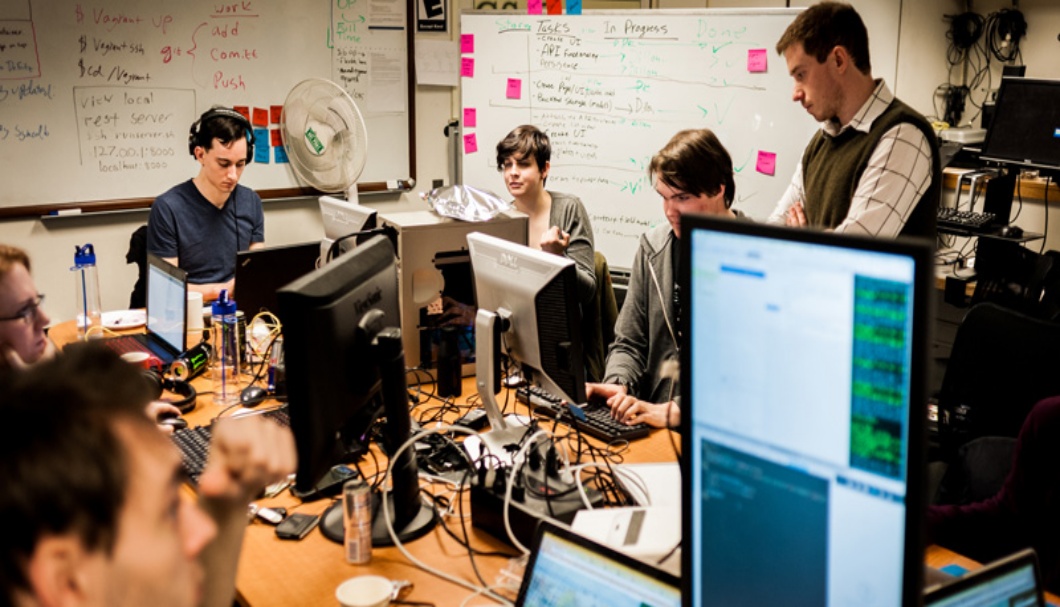Development team
Typical Software Development Team Structure and Roles
Nowadays technology is gradually dominating in all fields and the growth rate is exponential, which means that in any field you will see technology giants or startups that are expanding their power and potential with new, smart, convenient and breakthrough technology products. And of course, the realization of these products deeply relies on the talented, creative and broad expertise of software development teams behind the scenes. In IT product development, they are completely fundamental to product success, contributing to every stage of your product lifecycle from discovery phase to successful product launches and then maintenance or further growth. But have you ever defined what is the software development team structure? Who does what in a team?
So, if you want to build your in-house development team or plan to hire a remote development team or even you are an IT company yourself, then hopefully this article will provide some critical and useful insights for you to answer these questions!
“Every product begins with the people on the cross-functional product team. How you define the roles, and the people you select to staff the team, will very likely prove to be a determining factor in its success or failure.” – said Marty Cagan, a Silicon Valley-based project management expert in his book Inspired: How to Create Products Customers Love.
Table of Contents
Driven factors behind a software development team structure
Before designing a software development team structure, it is essential to consider factors that will be an effect to your recruitment plan, your company’s potential, goals, and especially to ensure that your IT project is in the hands of a qualified team of professionals. Here are some key factors that influence your decision about an effective software development team structure, and keep in mind that these factors will be inextricably intertwined together!

The complexity of the project
The scope and complexity of your project will dictate the size of your team as well as the roles of the people you will need on your team. For example, if your project is at the proof of concept stage or building a product prototype then the team of four to six members may be enough to accomplish all tasks and they may include: a product owner, project manager, business analyst, UI/UX designer, software architect, etc.
However if you are going to launch a fully functional product with lots of new features or you are about to redesign an existing app and upgrade the product, your team needs to be expanded with more experts.
The time to complete the project
With any project before it starts, there must be a specific time to completion and this will also directly affect your software development team structure and its scale. And it is also pretty obvious that if you have fewer members, the time to complete the project will be quite long.
But in case you already have a plan in place to develop your product from scratch and have a tight timeline for releasing the final product, then you will properly have to build an expanded team of senior engineers and professionals to quickly fulfill every need and deliver productivity efficiently. In other words, the less time you have to deploy the product, the more experts you need to be involved throughout the process.
The budget allocated to the project
The amount of budget you have available to cover the entire project will limit the number of members of your team and even the seniority and experience of the professionals you want to hire. Because in fact, just focusing on gathering and recruiting talent into your development team will cause you a headache about “tremendous” expenses, so be really wise when building a development team to make the most and efficient use of the financial resources you have.

Read more: Tips for Building a Successful Software Development Team
Software Development Team Structure Approaches
The above factors affect how your team structure is formed. There will be basically three main approaches to team structure in software engineering: Generalist; Specialist; Hybrid and each type will be suitable for certain projects.
Generalist
This is a team of professionals with broad and versatile knowledge in a variety of development skill sets. For example, a UX/UI designer on the team may also have some knowledge of Java. This creates a strong opportunity for learning and exchange in the group thanks to the diverse knowledge across a vast range of areas of the members, plus each member will also have the ability to complete their work without depending on others.
However, the downside of this “one team for all” approach is that for tasks that require highly concentrated specialization, the group of generalists will often not be able to respond due to the lack of depth and specific skill sets. This team will be suitable for projects of medium complexity and time sensitivity and with limited project budgets.
Specialist
A “Specialist” software development team structure involves experts in a certain development stack, programming languages or frameworks. Each member is typically highly skilled in one field and fully responsible for their part of development. This approach is perfectly suited to projects that are complex, have a wide scope of work and require in-depth technical expertise. Besides, with tasks that are clearly divided and they can be simultaneously performed, it will contribute to speeding up the completion of tasks with unexpected results.
However, with a group of experts, the interdependence is very great and the members are not interchangeable, that is, if they are faced with a different task in the course of their work, they will need the help of a member who specializes in that area. In addition, the risk of miscommunication is higher due to possible lack of general understanding of the project.
Hybrid
As its name suggests, this software development team structure is a combination of both Generalist and Specialist, so Hybrid teams are often ideal for projects with extreme complexity, large scale and tight deadlines.
With this team approach, the specialists will deeply tackle technical problems that require narrow expertise, while the general experts cater for integration and general software development. Throughout the process, the support between members is extremely large, helping to maximize work efficiency, promote the strengths and minimize all weaknesses of the previous two approaches.
However, the hybrid approach cannot avoid its limitations and its biggest drawbacks are that to build a team with many experts at the same time will be extremely expensive, difficult and time consuming, and also requiring strong management that can coordinate all the diverse parts of the workflow.

Software Development Team Roles and Responsibilities
In fact, technology projects will often be very diverse so each development team will often be different and unique in each project. In other words, depending on the approach of the business and many other factors, the software development team structure will be different, each member will play an important role in delivering the software on time and ensuring the efficiency of the process. Here are some of the roles and responsibilities of each person on a development team.
Project Manager (PM)
The project manager acts as the spokesperson for both the client and the development team, serving as a bridge for technical and people related issues. The PM will perform analysis and evaluation of the client’s requirements to create a development plan in accordance with the agreed scope, budget, and timeline.
In fact, although PM is not directly involved in product development, their role is irreplaceable. This person is in charge of multiple different tasks from the beginning to the end of the project, is accountable for the deliverables, takes responsibility in handling risks or arising that make the work progress deviate from the original plan, and also has control for all execution, authorization, scheduling, etc.
A quality project manager in the technology sector requires extensive expertise in many areas such as project management skills including budget estimation and control, planning, management quality and communication, financial analysis and reporting, in charge of resource management, solid knowledge of software development, etc.
Product Owner (PO)
The Product Owner is the person responsible for solving product and end-user issues, as well as operating and improving the product to achieve the company’s goals and visions. All PO decisions must be based on actual data, in order to maximize return on investment and determine product features. PO defines business strategies, form product visions and manage product backlogs based on a balance of both business needs and market trends.
Since the PO will be the one accountable for the entire product, even after the product has been released, the PO still has to monitor the indicators and the user’s reaction to change and adapt as necessary. Each decision of the Product Owner is very important and is a guiding light to the development team, which requires the Product Owner to have excellent skills of a manager, have a long-term vision and understand the product clearly, thereby being able to lead the team to the final result.
Team Lead
If PM is usually assigned to each project, Team Lead is usually a permanent role and of course this role is extremely important. Team Lead acts as the face of the development team, communicating and exchanging directly with PM and BA to capture information, clarify orientations and then assign specific tasks to software developers. Thereby, Team Lead helps upper-level managers to be regularly updated on project status, and at the same time keeps their team from being distracted.
Besides, the team lead will act as a coach helping to solve more complex tech tasks or review the code and also responsible for preventing and resolving conflicts.
Tech Lead
Tech Lead is responsible for directing and leading the entire technical side of the team. This person is heavily involved in decisions about code structure, codebase quality management, and technical development of the team. Besides, Tech Lead will monitor, provide optimal solutions, resolve disagreements and manage the entire technical quality.
Not only in the role of mentoring and guiding the team to get on track, Tech Lead is also a facilitator in the product and process development plan, assisting the team in responding to stakeholders about the system and technical.
Business Analyst
In fact, a business analyst may be involved even before the software development team structure has been determined from the feasibility and baseline stage. BAs play an important role in both the technical and business aspects of the software development process, connecting business’s desires, overall business model and the client’s vision to development team.
In other words, this person will optimize business needs and identify effective solutions from a technical as well as a business perspective, ensuring the final product meets the market needs as well as the customer needs and get the most profit in the future
At the same time, BA will help the product development team gain a deeper understanding of business processes from different perspectives and the ability to create products that bring maximum business value.
Software developer
Software developers or software engineers or programmers are masters of coding who will apply their knowledge of programming languages to build exactly what you expect to see and run on your product. They are a particularly important factor in the success of software development and although they all code, in software development team structure, different types of programmers will carry certain duties and roles.

Front-end developer:
When accessing a website or application, the interfaces that the user interacts with such as the search bar, images, input fields, navigation, etc. are all created by front-end developers to increase the usefulness and user-friendliness of the product.
From design ideas they convert it to code and strive to deliver a smooth and pleasant user experience on any devices, platform or operating system. Popular languages that front-end developers use include HTML, CSS, JavaScript, etc. and use frameworks like AngularJS, Backbone, Ember, ReactJS, etc.
Back-end developer:
If what the front-end programmer does will be exposed to the outside for users to interact and use, the activities back-end developers do are often not seen, they focus on building the core of the project. Backend Developer also known as server-side development and focuses mainly on database, Backend logic, API and Server.
The back-end developer is responsible for the logic, construction, data computation, and overall stability of the system. They must ensure continuous communication and response between servers, applications, and databases, helping the browser to communicate with the database.
Many server-side languages are mainly used in front-end development including: Java, .NET, PHP, NodeJS, Ruby, etc. In addition, programmers also use data tools to perform the above tasks such as MongoDB, MySQL Oracle to manage and update data or delete and serve data back to the client or the user interface of the application.
Full-stack developer
Full-stack developer is a general-purpose developer who has experience and knowledge regarding both front-end and back-end. They can work on every architectural layer of the system from client to server to database and all necessary integrations. Although, a full-stack developer won’t be able to handle the front-end techniques as intensively as a front-end expert, they certainly have enough understanding of the many components and how they interact in the development process, then know how to combine into a finished product.

Quality Assurance Engineer (QA)
The software development process is often very complex and error prone, in fact even the most skilled software developer cannot avoid errors in implementation. Hence the presence of a QA Engineer in software development team structure is extremely important.
This person plays the role of testing and verifying whether an application meets the requirements, both functional and non-functional applications. In other words, they will be the ones to detect bugs and problems before the end users do and control the correctness of all stages of development.
QA verifies an application from multiple aspects ranging from functionality, usability, security or performance, etc. from an end-user perspective, followed by analysis of test results and reporting on application quality.
UI/UX Designer
For the product design process, there are 2 aspects that are user experience design (UX) and user interface design (UI). UI and UX are closely related and both aim to optimize the presentation of a product, improve usability, ease of use and interaction between the customer and the product in order to enhance customer satisfaction. It is because of the inseparability of both UX and UI that in most companies use both of these titles for a single position.
UX designers will conduct in-depth research on users, and their persona development, design information architecture, wireframing, prototyping, and more. Specifically, they will determine the most effective design when conducting performance testing with usability testing, ensuring all features are user-friendly, as their main focus is on functionality and usability.
UI designers have to ensure the visualization of everything that customers will see when using the product including layout, colors, fonts, images or charts, etc. A UI designer’s top priority is to find solutions to design and enhance the user experience, and to help convey messages from designers, product and service providers to users.
Software architect
The Software Architect will be responsible for designing the framework for the system, controlling the interaction between the components in that and making high-level software architecture choices. Although this person does not directly design the software, he is the one who makes the ultimate decisions about designing the big features and choosing the right tools and technology platforms to implement the product vision.
The Software Architect must closely follow the Developer team when building or operating the system, as well as when maintaining and expanding the system to ensure smooth, efficient, safe and stable operation.
Conclusion
The success of any project will be influenced by many factors, but the most important factor is identifying the talents who are directly involved in the product development process at all stages. Hopefully our article on software development team structure will help you have the most general overview of the roles and responsibilities of a software development team.
However, determining the most optimal software development team structure is also not that easy, a software development technology partner will help analyze the needs and recommend the most optimal team composition to meet the potential and capabilities of your business. Hence if you are wondering about an effective, appropriate software development team structure, then fram^ can definitely help you! Tell us your story, and we’ll give you the people to make it happen!


